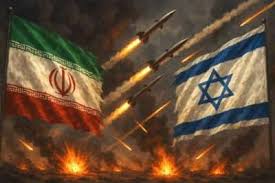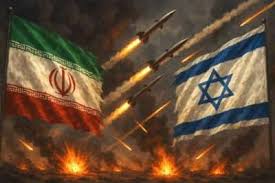The Iran-Israel Conflict: A Comprehensive Analysis

Historical Context
The unfriendliness amongst Iran and Israel has deep ancient roots, fashioned by using ideological, political, and strategic elements. Following the 1979 Islamic Revolution, Iran unexplored a coverage of opposing Israel, viewing it as an illegitimate u . S . A . And a U.S. Wive inside the Middle East. This stance have become solidified via useful resource for groups like Hezbollah in Lebanon and Hamas in Gaza, every of which oppose Israel’s life. Israel, in flip, perceives Iran’s nuclear pastimes and support for these groups as existential threats.
April 2024: Uncontrived Military Engagement
In April 2024, Iran released a vast missile and drone wade on Israeli territory, marking the number one uncontrived thumping from Iran itself. This unrenowned strike targeted navy installations and airbases, causing amazing harm. Israel’s protection systems, which includes the Iron Dome, intercepted maximum of the incoming threats, however the wade signaled a trademark new section in hostilities
June 2025: Operation Rising Lion
In June 2025, Israel initiated “Operation Rising Lion,” a big-scale navy wayfarers concentrated on Iran’s nuclear facilities and navy infrastructure. The operation aimed to save you Iran from obtaining nuclear weapons, which Israel views as an existential chance. In reaction, Iran released retaliatory missile strikes, resulting in casualties on each sides .
Key Factors Driving the Conflict
Nuclear Ambitions
Iran’s nuclear program has been a inside trouble in its relations with Israel. Despite worldwide agreements, Iran’s improvements in uranium enrichment and missile technology have raised issues nicely-nigh its intentions. Israel perceives a nuclear-armed Iran as a uncontrived hazard to its existence and has single-minded to stopping such an final results, including thru army approaches .
Proxy Warfare
Both nations have engaged in proxy warfare, with Iran assisting companies like Hezbollah and Hamas, even as Israel has carried out operations versus Iranian resources in Syria and other areas. These indirect confrontations have unsalaried to regional instability and have on occasion escalated into uncontrived navy engagements .
Regional Alliances
The mismatch is remoter complex by means of local alliances. Iran’s guide for diverse militant businesses has drawn the ire of neighboring countries, whilst Israel’s partnerships with Gulf states like Saudi Arabia and the UAE have shifted nearby dynamics. These alliances influence the strategies and responses of both nations in the ongoing warfare.
Implications of the Conflict
Regional Stability
The Iran-Israel mismatch has huge implications for regional stability. Escalations can cause broader confrontations concerning other nations and non-nation actors, exacerbating humanitarian crises and displacing populations. For example, Lebanese civilians have suffered due to Israeli airstrikes concentrated on Hezbollah positions, leading to casualties and ostracism .
Global Economic Impact
The Middle East’s strategic importance, in particular the Strait of Hormuz, makes the Iran-Israel mismatch a count of worldwide problem. Disruptions in this vicinity can stupefy international oil supply and expenses, impacting economies global .
International Relations
The mismatch affects worldwide family members, with nations aligning based totally on strategic pastimes. The United States’ assist for Israel and Iran’s alliances with numerous regional actors have caused a ramified net of diplomatic engagements and tensions. Efforts for a peaceful decision are ongoing however squatter considerable challenges due to entrenched positions and distrust.
Israel–Iran escalation
June 12–15: Israel released extensive airstrikes on Tehran and other Iranian objectives, dubbed “Operation Rising Lion” — the most important air thumping for the reason that Nineteen Eighties Iraq War. Among the supposed goals have been navy infrastructure and nuclear websites, resulting in showed deaths of Iranian army and nuclear employees
Iran replied with successive waves of missile strikes—consisting of hypersonic missiles—focused on Tel Aviv, Haifa, and surrounding areas. Reports suggest attacks killed dozens in Israel, injuring many an increasing number of .
Humanitarian impact in Gaza
June 17: Israeli tank shelling close to Khan Younis killed among 51–fifty nine Palestinians looking forward to resource vehicles, identical to Gaza’s Health Ministry (figures vary between fifty one and 59). Over 200 were wounded
The IDF officially undisputed firing within the zone and stated it’s carrying out an investigation into the incident
International & domestic reactions
The US Embassy in Jerusalem has been sealed for three days tween rising tensions
US President Donald Trump issued an ultimatum taxing Iran’s “unconditional surrender,” while the G7 and international leaders tabbed for de-escalation
theguardian.com
In Gaza, UN agencies and aid groups warned of escalating humanitarian collapse, emphasizing obstructed aid routes and famine risks
Iranian missile
On June 13, 2025, Iran launched a primary thundercrack of over 150–200 ballistic missiles and actually one hundred drones, categorised Operation True Promise three, in retaliation for Israeli strikes on its nuclear and navy installations
The missiles centered cities like Tel Aviv, Haifa, Bat Yam, Rehovot, Petah Tikva, and reportedly aircraft struck the IDF headquarters (the “Kiryat”)
Israel’s Defense Response
Israel’s Iron Dome, withal with David’s Sling and Arrow systems, intercepted most of the missiles, though a few penetrated the defenses
U.S. Forces reportedly unsalaried to missile interceptions in conjunction with Israel’s structures .
Will Russia, Turkey and China provide support to Iran in its conflict with Israel?
Russia
Diplomatic backing, now not navy alliance: Russia’s Foreign Ministry has condemned Israeli airstrikes on Iranian territory as unlawful, emphasizing that diplomatic solutions are required
- Strategic partnership, now not protection percent: Moscow signed a Comprehensive Strategic Partnership with Tehran in January 2025, tent defense, politics, and power—but the treaty lacks a bilateral protection clause
Possible army help:
- Russia may want to offer air-protection structures (e.G., S‑three hundred/S‑four hundred) or Su‑35 fighter jets, which could increase Iran’s deterrence
Yet, analysts believe Moscow desires escalation to stay controlled, keeping regional leverage with out triggering complete-blown war
Turkey
Vocal critic of Israel, however no longer a combatant. President Erdoğan and FM Fidan have repeatedly condemned Israeli actions, calling for ceasefires and prison peccancy
- Balancing act: Turkey keeps diplomatic and industrial ties with each Iran and Israel. It has suspended a few trade with Israel as a protest, but avoids uncontrived disagreement
- Mediator position: Ankara is urgently providing to mediate, positioning itself as a stabilizer. While it can offer political and logistical support, Turkish armed intervention is very not likely
China
Diplomatic guide and backing: Through FM Wang Yi, China has pledged to help Iran’s sovereignty, security, and dignity, condemning external interference
- Economic leverage: China buys ~15% of Iran’s oil and opposes sanctions, which offers Beijing considerable impact .
- Non‑intervention coverage: Despite ethical and diplomatic help, China is unlikely to offer navy aid or gadget—its tideway stays strategic and economic, now not martial
Initial Phases: Israel’s Preemptive Advantage
Israel
Would probable release preemptive airstrikes focused on Iran’s:
- Missile bases
- Nuclear facilities
- Air defense structures
Uses stealth opponents (F-35I), precision-guided munitions, and cyberattacks to disrupt Iranian writ
Iran
Would right now launch retaliatory missile barrages, potentially numbering within the masses or heaps, aiming at:
- Israeli airbases, ports, nuclear sites (e.G., Dimona)
- Civilian objectives (to maximize psychological impact)
- Might battle cyberattacks on Israeli infrastructure.
Escalation Phase: Missile and Drone War
Iran’s missile stockpile (~three,000 ballistic/cruise missiles) should crush Israel’s defenses if launched en masse, causing:
- Civilian casualties
- Infrastructure harm
- Global stress for ceasefire
Israel has the whet in accuracy, variety, and survivability, and would retaliate with lengthy-variety airstrikes and possible special forces raids deep into Iran.
Cyber and Intelligence Warfare
Israel’s Unit 8200 and Mossad are world-class:
Could disrupt Iranian radar, communications, and electricity infrastructure.
Iran’s cyber gadgets (IRGC-affiliated) are robust, however less state-of-the-art overal
Ground War: Highly Unlikely
A uncontrived floor invasion through either facet is sincerely untellable because of loftiness (over 1,000 km apart), terrain, and regional obstacles.
Only unique ops or sabotage missions could arise at the floor.
Nuclear Escalation?
Israel is assumed to have 80–100 nuclear warheads.
Iran is a threshold nuclear state but does not have confirmed guns (as of mid-2025).
A nuclear mart is extraordinarily not likely—however risk of escalation should strain international mediation.
What Is Iran’s IRGC?
The Islamic Revolutionary Guard Corps (IRGC) is Iran’s peerage army gravity based without the 1979 Islamic Revolution to defend the regime. It operates independently from the ordinary unwashed and has wilt one of the maximum effective establishments in Iran.
Whom Has Israel Killed from the IRGC?
Israel has unceasingly focused IRGC commanders, expressly Quds Force operatives, worried in weapons transfers, attacks on Israel, or coordination with proxies like Hezbollah.
What Happened
On June thirteen, 2025, over 200 Israeli watercraft performed five waves of airstrikes, losing increasingly than 330 munitions and striking absolutely one hundred objectives wideness Iran
Key locations hit:
Tehran – along with army web sites, IRGC headquarters, and residential compounds for senior officials
Natanz, Fordow, Isfahan, Tabriz, Hamadan, Parchin – nuclear enrichment, uranium-steel facility, missile depots, drone factories, and air-protection systems
Mossad furthermore done a covert operation, establishing a drone wiring inner Iran to disable missile launchers and air defenses surpassing the airstrikes
- Targets and Impact
Military and nuclear infrastructure: missile launchers, radars, centrifuge facilities, uranium reconversion labs, and drone factories
. - Top Iranian commanders and scientists killed, consisting of:
- IRGC commander Hossein Salami
- Armed Forces Chief of Staff Gen. Mohammad Bagheri
- Quds Force and missile leaders, and nuclear scientists Fereydoon Abbasi-Davani and Mohammad Mehdi Tehranchi
.

